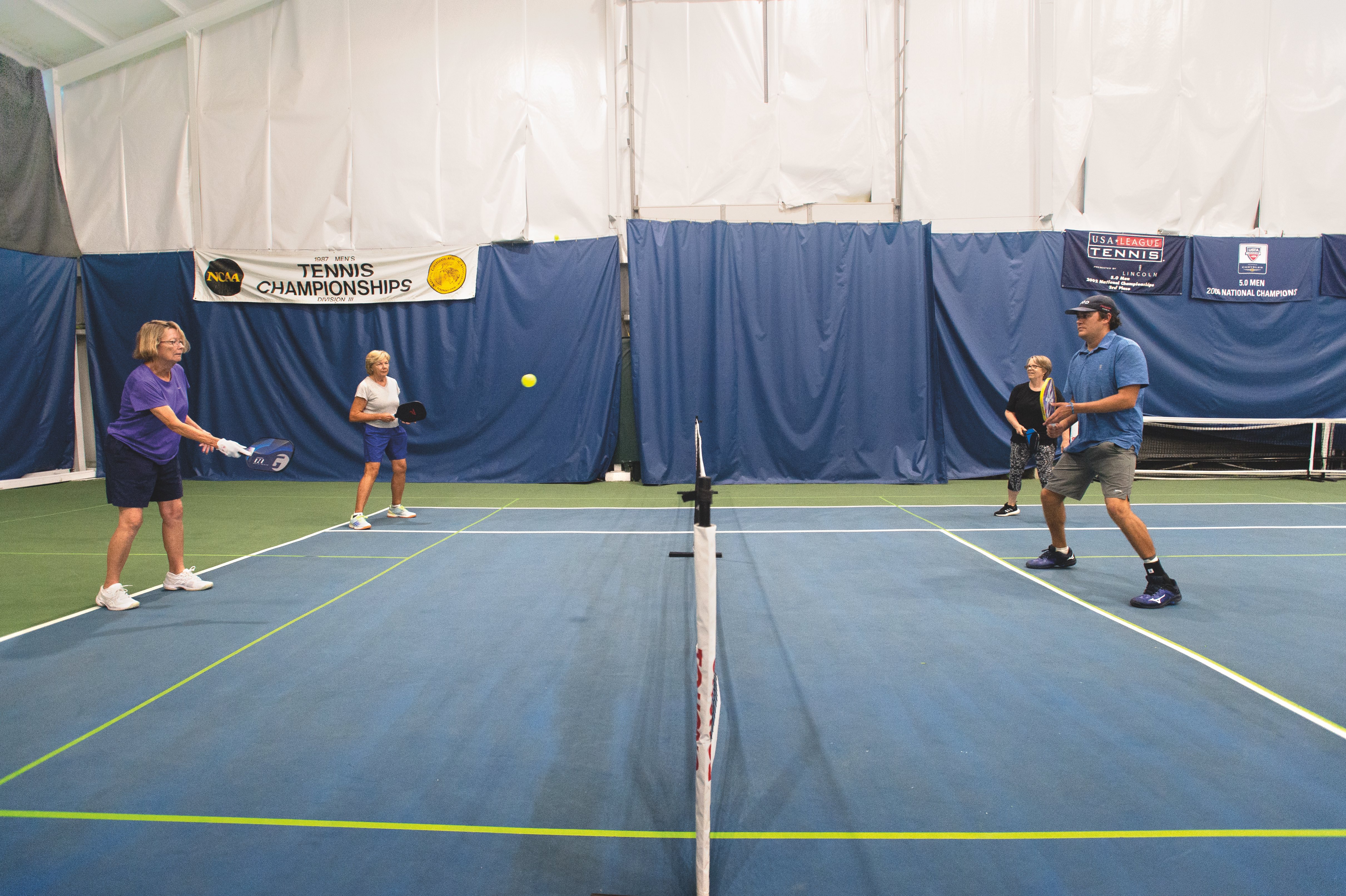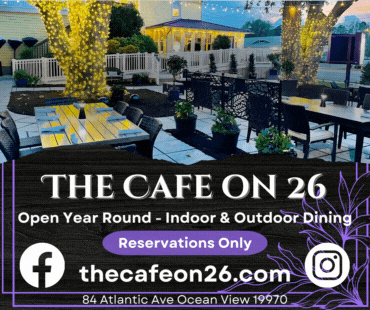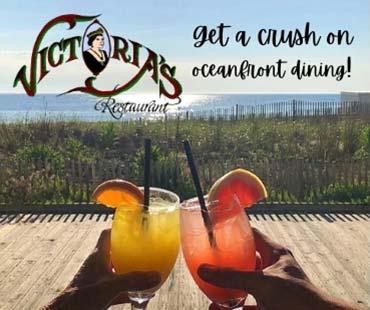
Fun and fitness combine to make pickleball increasingly popular in coastal Delaware
By Chris Beakey
Photograph by Scott Nathan
From the July 2022 issue

Over the past several years, Ginny Rickards and her teenage grandson, Jason, have learned to surf together, spent long days on the Rehoboth boardwalk together, and shared too many wonderful family meals to count. But then, just when she thought life couldn’t get any better, they both discovered pickleball, one of the nation’s fastest growing sports and now her family’s favorite way to stay in shape.
“Jason started first, in May of last year,” she recalls. “I watched him play with my daughter, Katie, over at the courts at Redden Ridge near Rehoboth. I was somewhat reluctant to try it because
I was never a real tennis player — I’d hit the ball around just to have something to do. But I was surprised at how different pickleball is — the ball is lightweight but moves fast, and once you start playing you realize how much better you get with practice.”
That point of view is enthusiastically shared by Jason, who at 14 is one of the youngest players competing in tournaments around Sussex County. It’s also a key reason why the game, which has typically been enjoyed by retirees who want to play a sport that’s easy on joints and muscles, is becoming popular with people of all ages.
According to the USA Pickleball Association, there are about 4.8 million players nationwide. That includes many in the Cape Henlopen region, some of whom are encouraging the public and private sectors to create more places to play.
That’s great news to Rickards, who now hits several times a week with Jason, Katie and friends she’s met through the game. “Once you start playing, you just want to play more and more,” she says. “I’m pretty sure it’s going to be a lifetime thing.”
Simple rules for a challenging game
If you’ve watched a pickleball match in action, chances are it was on a tennis court that’s been temporarily altered, with a portable net dividing a playing space that’s 20 feet wide and 44 feet deep, which is about the size of a badminton court. In some ways it looks like tennis, with players hitting forehands, backhands, volleys and overhead smash shots — but with a paddle instead of a racquet. And, because the hollow ball is made of plastic, you can’t mistake the distinguishing bonk sound it makes on impact.
It’s a joyful noise for avid players that’s amplified immensely during matches at Dave Marshall Tennis & Fitness outside Lewes, Sea Colony in Bethany Beach, and Sports at the Beach in Georgetown. All three facilities host hitting sessions with large numbers of players several days a week and cater to players at various levels with lessons and clinics. Local devotees of the sport can also find courts at various locations in Rehoboth, Lewes, Georgetown, Millsboro, Millville and Dagsboro. (See “Places to Play,” page 64.)
There are many reasons why the game has become popular. Players generally find it easy to develop basic skills and many become competent competitors after a few weeks of practice. It’s also gentler on the body than tennis and racquetball because the movements are smaller and because players don’t have to run as fast or far given the smaller size of the court.
The path to improvement
That said, many come to realize that even though pickleball is easy to learn, it’s difficult to master. Jackson Bailey, a teaching pro at Dave Marshall, is someone players turn to when they want to reach a higher level. While those who take home the most trophies tend to be highly experienced and gifted athletes, he coaches many others with average athletic abilities who go on to compete successfully in local tournaments.
“Winning is all about positioning, shot selection and decisiveness,” he explains. “Positioning is important because it’s hard to win any point if you’re not in the right place on the court. You master it by being able to adapt to the situation you’re in.”
As an example, he describes a doubles match with himself and his partner back at the baseline and their opponents much closer to the net.
“The worst thing I can do when I’m way back there is to try to hit a power shot because they’ll have lots of time to react and just knock it down. What you want to hit in that situation is either a low ‘dinking’ shot at their feet, which is hard to get back, or a ball that goes high over their heads and forces them to run back for a ball that’s harder to return.”
He adds, “You can’t really select the right shot until you master all kinds of shots — forehands, backhands and volleys.” Bailey also notes that volleys in pickleball might initially be more complicated for players transitioning from tennis because balls can’t be hit out of the air if you’re within 7 feet of the net — a territory known as “the kitchen.” In that case you have to wait for the ball to bounce before you can hit it.
The third winning skill — decisiveness — tends to evolve only after many hours of practice.
“Sometimes you mess up when you have too much time to get to a ball — meaning too much time to think about too many different ways to hit it,” he says. “You want to set your mind to the shot that’s going to put you in the best position to win the point, whether that’s a volley, a penetrating forehand or a lob that’s going to force those opponents at the net into an uncomfortable defensive position.”
“Don’t be wishy-washy,” he says with a laugh. “Just commit to the right shot and hit that ball for a winner!”
Those strategies are put to good use by Todd Muller, a longtime tennis player who also plays pickleball, and his partner, Jaaron Graham. Both are in their 40s and among the younger players in peak physical condition who have gravitated to the game. They’ve also found ways to tailor their play to their own fitness goals by playing against each other instead of the round-robin doubles matches that are more common at large facilities.
“We enjoy singles because it’s healthy competition,” Muller says. “We also like the workout aspect of our hour-and-a-half-long singles matches.”
Both have become skilled players, yet Muller emphasizes that they’re in it first and foremost for fun.
“We learned pickleball organically — just bought the paddles and started playing. We’ve never taken lessons but have watched some competitive matches on TV and picked up pointers. … But I know we can make subtle adjustments to improve our game. Our advice is to just get out there and do it. Enjoy the movement. Enjoy the competition. And enjoy the process of getting better.”
ISO ... more courts!
While First State Pickleball Club President Andy Staton has noticed a large number of players aiming to be more competitive, he says many just want to have a good time and play as often as possible, even if it means driving a ways to find an available court.
“There’s so much camaraderie in this game, and it’s a great way to be more social while you’re getting fit,” he says. “I’ve met people who might have tried to stay in shape by walking their dogs for half an hour but are now playing pickleball for two hours for a great cardio workout. Unfortunately, there just aren’t enough public courts, but we’re hoping that’ll change.”
Staton estimates there are more than 2,000 frequent players in Sussex County, with membership in his club up more than 30 percent from this time last year. He’s excited about the further development of Sandhill Fields near Georgetown, where a public-private partnership is paving the way for a new fieldhouse that will feature a sports court for field hockey and indoor pickleball courts in addition to the six outdoor courts already in place.
As a real estate agent, he also believes it’s a smart move for developers of new communities to install pickleball courts. That’s based on more than intuition: Architectural Digest declared in March that pickleball courts have replaced golf courses as “the hottest sports amenity in high-end developments.” Equally telling is the Sports & Fitness Industry Association’s “2021 Topline Participation Report,” which showed a 21.3 percent increase in the number of pickleball players nationwide in 2019.
Jeff Evans, the director of sales and marketing for Carl M. Freeman Companies, represents one of many local developers responding to both market research and rave reviews for the game.
“We just added two new pickleball courts at Bayside at Fenwick Island because our residents asked for them, and are building courts at Tower Hill off New Road in Lewes because we know they’ll be a great incentive for buyers and something the residents will really enjoy,” he says.
Evans bases that opinion on the company’s deep experience creating communities built around active lifestyles, where amenities such as pools, tennis and pickleball courts, along with organized activities, are all included. He’s also reacting to what he heard at the recent Ideal Living Expo in McLean, Va., which spotlights communities that are especially desirable to folks who will soon retire and those seeking vacation homes.
“No one who was there to learn about new developments asked about tennis. They wanted to know about designated pickleball courts because they all thought it’s much more fun, and because they weren’t as sore after playing pickleball as with other sports.”
Longtime First State Pickleball Club member Kathy Casey seconds the notion that the game is a smart amenity for active adult communities because it’s had a life-changing impact on her own health.
“I blew out my knees at the age of 30 and could hardly do anything physically demanding for a long time,” she says. “But then a few years ago I went down to visit a friend in Florida who lives at The Villages. She kept talking about pickleball and talked me into trying. I had to rotate in with people I didn’t know and was terrified. But then, all of a sudden, I was hitting all these balls! Once I got my rhythm it was so exciting. … I realized: Oh my God, I can be an athlete again!”
Although she’s also noticed many younger players showing up for round-robin play, including “uncles with nephews, people 25 to 30 years old and a guy I met at Casapulla’s who told me he loved it in high school,” she’s become a true ambassador for a sport tailor-made for retirees who want vigorous exercise that drives longevity and a happy state of mind.
“My knees feel fabulous — I no longer have any problems with them at all. It’s almost like this little athlete wakes up and just wants to play.”
And for anyone who’s still on the sidelines because they’re worried they won’t hold their own with experienced players, she offers simple advice:
“You can do this even if you don’t have great hand-eye coordination. Just start, and follow the ball and pretty soon you’ll be like me, playing for three hours and always ready for just one more game!”



